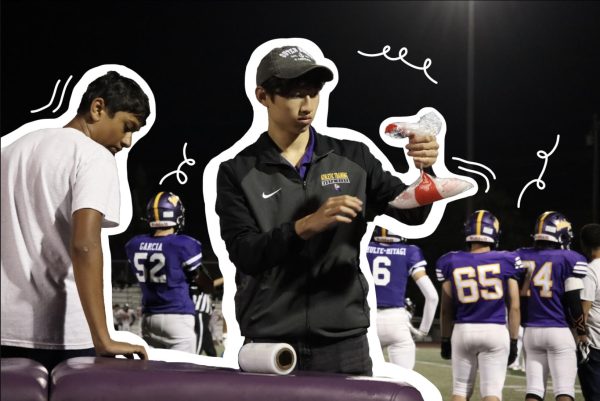Senior Nathan Lee’s transgender journey
Lee explains his experiences of being a trans athlete
*Editor’s note: some phrases in this article were corrected in order to respect transgender people (4/5/20).
Senior Nathan Lee has been swimming with the MVHS Swim team since his freshman year and with Peak Swimming club teams years before. However in his junior year, Lee started swimming with the boys team rather than girls after coming out as a trans-male.
Lee began his competitive athletic career with Peak Swimming in head coach Chris Scott’s swimming group in 2012. Afterwards, Scott coached Lee on and off for approximately five years as Lee advanced into higher levels of swimming. After Lee first notified Scott of his intention to transition from female to male, Scott noted that USA Swimming was able to provide an accessible leeway to accommodate Lee’s future swimming meets. According to Scott, USA Swimming facilitated a streamlined step-by-step process to ensure that Lee’s swimming transition would be smooth.
Lee started questioning his gender identity in the summer after his sophomore year in 2018 — by December of that year, Lee knew he was transgender. In 2019, Lee started second semester taking on the new name, Nathan.

Shortly after Lee announced his transition, Scott noticed that it seemed like there was a weight lifted off of Lee’s shoulders — Lee was able to fully enjoy the sport without pressuring himself to lower his time on event performances.
“There was just a big mental block in swimming,” Lee said. “… I still haven’t [reduced swim timings] in life, quote, unquote, best event for three or four years now. So right before I transitioned, I was like, I have to learn how to swim for myself instead of swimming for time… I might as well just do this for myself instead of forcing myself to go fast and then beating myself up, but I’m not dropping time.”

Upon entering the MVHS boys swim team last spring, Lee notes that fitting in with the team’s social dynamics didn’t pose an issue, as the swim team was co-ed prior to this year. With this, Lee had already befriended a number of members on boys swim before making the transition.
Senior and boys swim team captain Ethan Lin indicates that Lee’s entry into the boys swim team was greeted with curiosity, as the cisgender males questioned the logistics of the transition and locker room circumstances. Lin denotes that this uncertainty was present among members of both the MVHS swim team and competing high school teams.
“Nathan got up on the block [when we were competing against Palo Alto HS] and Paly parents exclaimed, ‘Wait, why is there a girl in the guys pool?’” Lin said. “That kind of confusion — our team got used to it eventually, but people outside of our team who weren’t quite sure of his situation [were] still confused about why he was there because he was still wearing a girls suit.”

After Lee told Scott about this incident, Scott praised Lee for handling the situation with control. Scott noticed that Lee wasn’t emotionally distressed about the incident, as he explains that Lee is very mature given his age. Scott notes that Lee was able to make the best of the situation by thoroughly and logically evaluating his circumstances and speaking for himself.
“One of the things he’s done a good job with is his basis of being very open minded [and] looking at the world — just trying to observe and understand without really passing judgment on things and on situations and on people,” Scott said. “I think he’s done a very good job of … really opening up and just having new experiences … Beyond just having an open mind and just making sure that you are able to absorb things and think about things [are] all part of the whole process.”
As a part of his transition, Lee underwent hormone replacement therapy by injecting testosterone shots, or male steroid hormones. By identifying as a male, Lee acknowledges the conversation about testosterone “advantages” — agility, strength and speed — in competitive sports. Because testosterone spurs muscle development, Lee notes that crowd viewers may discern transgender individuals as bearing an unfair competitive advantage than cisgender females.
However, Lee believes that this is a misconception because of the scientific articles he has read — according to Lee, cisgender females can be stronger than transgender females.
“I don’t think I would have had a really big advantage being on testosterone and competing against other cis-girls,” Lee said. “But that would be the reception that I would have gotten. And I think there would be a bigger push back from that.”
Lee mentions that this misconception has created a lot of push back for trans athletes in the sports community. According to an NBC news article by Associated Press, conservative states such as Idaho banned “transgender women from competing in women’s sports despite warnings that such a law is unconstitutional.” In response to this law ban, Lee believes it’s critical for the common public to recognize that trans athletes deserve a spot in sports.
“I think the backlash against trans athletes in sports comes from a place of hatred, ignorance, trans phobia, all of that,” Lee said. “And I just really hope that with more people who are trans and out and competing, the world will end up changing.”





